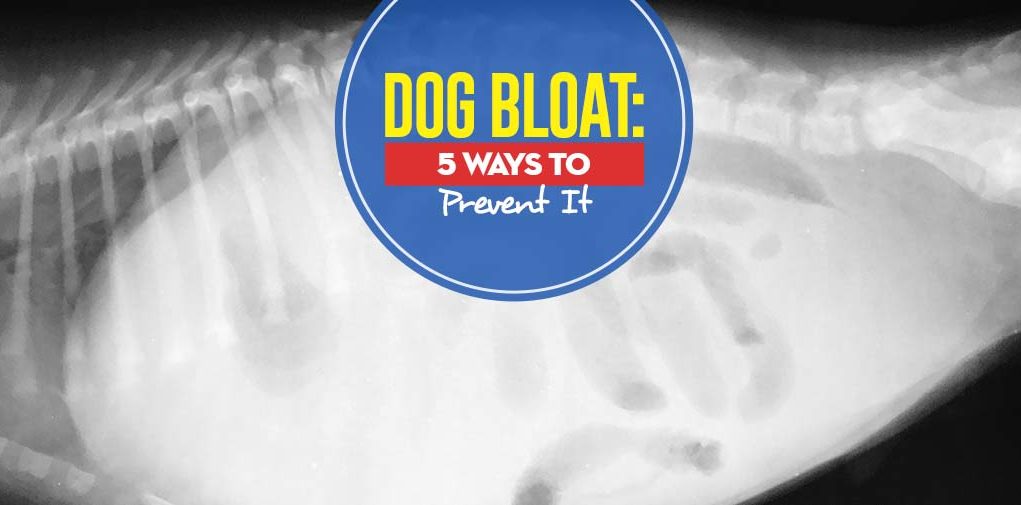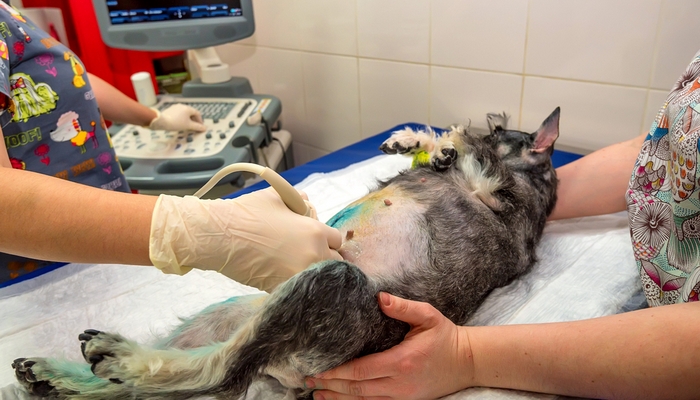Bloating in humans isn’t usually that big of a deal. It might makes you uncomfortable for a brief period of time, and usually you’re fine. That is not the case with dog bloat. For dogs, bloat can be very serious, even deadly.
Many dogs die from bloat every year. There is no home treatment for bloat. If you suspect that your dog might have bloat it’s critically important to get them to a vet immediately. Don’t wait. If your regular vet isn’t available go to the closest emergency vet.
“The dog is fine one minute and in a life-threatening situation the next. Dogs often die from bloat while their owner is off at work or sleeping at night.” – Tufts University
Don’t hold off to see if your dog can wait until morning just to ensure you get in with your usual veterinarian. The sooner you get medical treatment for your dog the better the chances are that your dog will live.
5 Ways to Prevent Dog Bloat
What is dog bloat?
Bloat in dogs is technically called Gastic Dilation and Volvulus. It can also be called GDV or canine ACD But, no matter what you want to call it, it’s deadly for dogs for when not dealt with properly and fast.
There are many different factors that can contribute to bloat. Some breeds, especially large and giant breeds with deep chests, are genetically prone to bloat.
Breeds most susceptible to canine bloat:
| Breed | GDV Risk Ratio | Risk Rank |
|---|---|---|
| Great Dane | 41.4 | 1 |
| Saint Bernard | 21.8 | 2 |
| Weimaraner | 19.3 | 3 |
| Irish Setter | 14.2 | 4 |
| Gordon Setter | 12.3 | 5 |
| Standard Poodle | 8.8 | 6 |
| Basset Hound | 5.9 | 7 |
| Doberman Pinscher | 5.5 | 8 |
| Old English Sheepdog | 4.8 | 9 |
| German Shorthaired Pointer | 4.6 | 10 |
| Newfoundland | 4.4 | 11 |
| German Shepherd | 4.2 | 12 |
| Airedale Terrier | 4.1 | 13 |
| Alaskan Malamute | 4.1 | 14 |
| Chesapeake Bay Retriever | 3.7 | 15 |
| Boxer | 3.7 | 16 |
| Collie | 2.8 | 17 |
| Labrador Retriever | 2 | 18 |
| English Springer Spaniel | 2 | 19 |
| Samoyed | 1.6 | 20 |
| Dachshund | 1.6 | 21 |
| Golden Retriever | 1.2 | 22 |
| Rottweiler | 1.1 | 23 |
| Mixed | 1.0 | 24 |
| Miniature Poodle | 0.3 | 25 |
* Risk ratios and ranks provided by vets at PetEducation.
If you have a large or giant breed dog – like a Great Dane, German Shepherd or Mastiff – you should always be on the lookout for dog bloat.
There are things you can do to lower the chances of your dog developing bloat, but once it occurs only veterinary treatment can help your dog. When bloat occurs the dog’s stomach fills with gas and twists in on itself. The gas can put pressure on the diaphragm, making it difficult for the dog to breathe.
It also can cut off blood flow to the heart. The gas pressure builds up in the stomach and it can cause the stomach to rupture. Bloat always needs to be treated as an emergency situation.
Symptoms of dog bloat
The symptoms of bloat at first may look like the symptoms of an upset stomach. Your dog may walk around a lot or just seem generally uncomfortable. The dog may nip at their sides, pace or cry.
If you see excessive drooling or if the animal has rapid, shallow breathing he could have dog bloat. Other symptoms of dog bloat include dry heaving and a distended or swollen stomach, as well as several other indicators.
RELATED: 5 Reasons Your Dog Has Canine Bloat and How To Prevent It
How to Prevent Bloating in Dogs
No one really knows exactly what causes bloat. But there are a few things that you can do to prevent it. If you have a large or giant breed dog that is prone to bloat genetically, you should always do these things in order to lower the chances that your dog will develop bloat:
1. Get A Puzzle Feeder
One of the things that can cause bloat is a dog eating too quickly. Especially if you are feeding dry kibble the dog can get bloat if they devour the kibble too fast. Get a puzzle feeder, or a dish designed to make your dog eat more slowly.
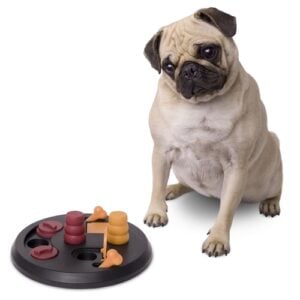 Dogs who have food insecurity issues often eat too fast and have anxiety about their meals. Using a puzzle feeder or a special feeding dish will force your dog to slow down and not inhale their food. If you have multiple dogs feed them separately so that they don’t feel any stress or anxiety about the other dog eating their food.
Dogs who have food insecurity issues often eat too fast and have anxiety about their meals. Using a puzzle feeder or a special feeding dish will force your dog to slow down and not inhale their food. If you have multiple dogs feed them separately so that they don’t feel any stress or anxiety about the other dog eating their food.
Top Dog Tips has featured reviews on two great choices for slow feeders. For more information you can read the full reviews on the:
2. Do NOT Use A Raised Feeder
Raised or elevated feeders are very much on trend, but they can be bad for your dog. There's a myth that elevated dog food bowls can actually combat dog bloat based on a poor study from a decade ago. However, this myth has been debunked with new studies.
An elevated feeder can encourage dogs to eat too much and to eat too fast. Use a regular bowl on the floor unless your vet has recommended that you use an elevated feeder.
If you have a dog that tends to eat very quickly don’t use an elevated feeder for that dog. Bowls on the floor might not look as chic as a trendy raised feeding table but it can make a big difference in your dog’s health.
RELATED: Mealtime Battle – Regular Dog Bowl vs. Raised Dog Bowl
3. Feed Several Small Meals
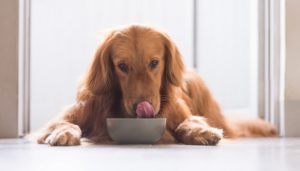 It’s much better to feed your dog several small meals throughout the day instead of only feeding your dog once or twice a day. Dogs that are fed only once or twice a day tend to develop some food anxiety. They anticipate their mealtimes and then when they are fed gobble down their food as fast as possible.
It’s much better to feed your dog several small meals throughout the day instead of only feeding your dog once or twice a day. Dogs that are fed only once or twice a day tend to develop some food anxiety. They anticipate their mealtimes and then when they are fed gobble down their food as fast as possible.
When you feed several small meals throughout the day the dog won’t get as anxious about meals and is more likely to eat the food at a healthy pace instead of just trying to eat as quickly as possible because they are quite hungry. Think about how you feel when you go all day without food.
When you do eat again, don’t you eat more and eat faster because you are so hungry? It’s the same for your dog. Feeding several small meals throughout the day is an easy way to prevent dog bloat.
4. Feed Canned Food
Some dog owners think canned food should be a luxury or a treat, but vets now overwhelmingly recommend adding canned food to a dog’s diet.
Canned/wet dog food has extra moisture which dogs need and it’s easier for a dog to digest than dry kibble. Mix some canned food with your dog’s regular kibble or switch to canned food exclusively if you want to prevent your dog from developing bloat.
A lot of dog owners don’t want to buy canned food because they think it’s too expensive. Canned food doesn’t have to be expensive. Many vets say that even inexpensive canned food is better for your dog than high quality kibble. Mixing the two is a smart and cost effective way to feed your dog and help keep the dog healthy.
5. Always Provide Fresh And Clean Water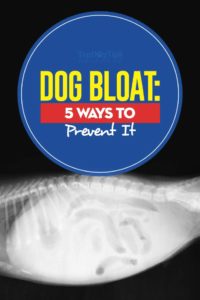
Your dog needs 24 hour a day access to lots of cold, fresh and clean water. Keeping your dog properly hydrated is important when it comes to preventing bloat.
If your tap water isn’t very appealing try using distilled water or bottled water for your dog. Or you can invest in a water filter for your tap or use a water filtering pitcher that is kept in the fridge. Giving your dog filtered water will encourage your dog to drink more.
READ NEXT: Top 5 Best Digestive Enzymes for Dogs


